Sign up for our newsletter
Explore more

The Best Law Firm Marketing Strategies
Where do you get leads for your law firm?
I asked several lawyers this question, and their most common answer was: word of mouth.
This wasn’t altogether shocking. After all, one of the best compliments to your skill is a referral from a past client.
What was shocking, or rather distressing, was that they were relying on referrals as the sole driver of their business.
Even large law firms with substantial marketing budgets are in the same position, relying on one form of marketing and forgetting about the rest.
That’s if there’s a marketing strategy at all.
In this article, I’m breaking down the TOP law firm marketing strategies and how you can build a plan to continually bring in leads for the life of your practice.
Article Contents
How Do Law Firms Get Clients?
Right now, around 49% of law firms simply buy leads from sites like Lawyers.com and Avvo.
Those leads can cost $250 apiece, making it a bit unsustainable in the long term, especially for smaller law firms and solo lawyers.
Even more so when there are ways to bring in law firm clients for free.
Jeni Lamb Rogers, Partner at PSL Law Group, knows how well a small, but effective marketing plan (with a $0 budget) can overshadow a large budget in a big firm:
I spend around 10-20 hours a month on marketing for my small firm, which is about the same as when I worked in large firms. But I’d watch them work with big development teams talking about big campaigns, but the people just wanted to talk to the attorney, the person representing them, to see how they’ll handle their high stakes case.
Today, she effectively drives clients to her firm through regular webinars and speaking engagements.
I used to go to a lot of expos and tradeshows… I do a lot of presentations and webinars, and afterward, I talk with people and focus on building that personal connection and delivering value, not trying to sell… People remember you, and they sometimes come back to you years later.
In a service-based industry, such as law, building meaningful connections and answering questions (providing value without selling) is the simplest but most effective way to reach clients.
Attending expos, showing your expertise through speaking engagements (or guest posts- a digital equivalent), and creating webinars are low maintenance (and free) marketing efforts that actually work for law firms.
But they aren’t the only methods. Small firms, solo lawyers, and large firms alike benefit from diversifying their marketing with a few digital methods.
Best Digital Marketing Strategies for Law Firms
The tactics you employ in your marketing plan should depend entirely on your clients.
Go where your audience already is.
That is the motto in marketing, or at least it should be.
Essentially, if all of your potential clients hang out on Twitter, then be on Twitter. Don’t build your presence on Facebook and expect to draw them to a new channel. It simply won’t work.
I tell you this because we’re about to dive into some of the most effective tactics in law firm marketing, and you might be all too eager to jump into them.
But without the proper planning (and skills), you could end up spending massive amounts of time, energy, and money on a strategy that doesn’t work for you.
We’ll delve deeper into planning later. For now, let’s look at some of the top ways to market a law firm.
Directories
We may not receive those big yellow paged books on our doorsteps anymore, but people still rely on directories to find the services they so desperately need.
One of the biggest reasons directories still exist is because they’re simple and easy.
Directories lay out all of your requested services within your area and tell you the most essential information about the service: average cost, types of services they offer, location, ratings, and reviews.
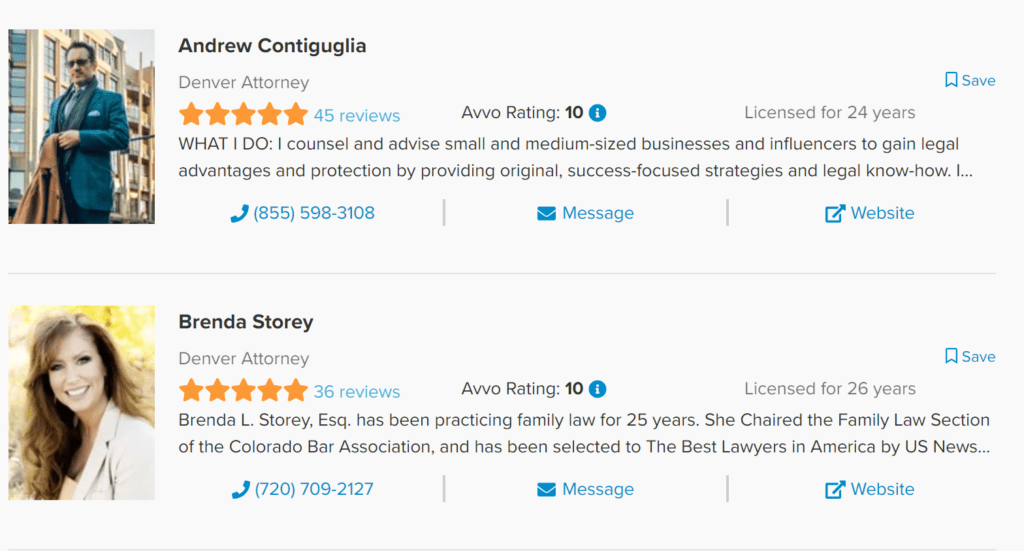
It’s easy to filter your search down to just a few options, read a few reviews, and cross services off the list until they find one they like.
Imagine if there were no directories, and searchers had to sift through dozens of google pages and scan each website to vet them.
It would be a hassle for your potential clients, and damaging for any business that appears further back than the first page of a Google search.
Adding your law firm to a directory is one of the most basic, yet vital ways to improve lead generation.
Top directories for law firms and lawyers include:
- Avvo
- Novo
- Lawyers.com
- Findlaw.com
Pay Per Click (PPC) Ads
Chances are, if you’re not spending most (or all) of your marketing budget on buying leads, you’re spending it on PPC ads.
PPC ads can yield great results when done right, typically bringing in $8,000 worth of revenue for every $1,000 spent.
Large law firms easily spend $10,000-$50,000 per month on PPC, knowing the results these ads can provide and also understanding this one thing about law firm clients:
They’re only likely to come across your information when they’re in search of a lawyer.
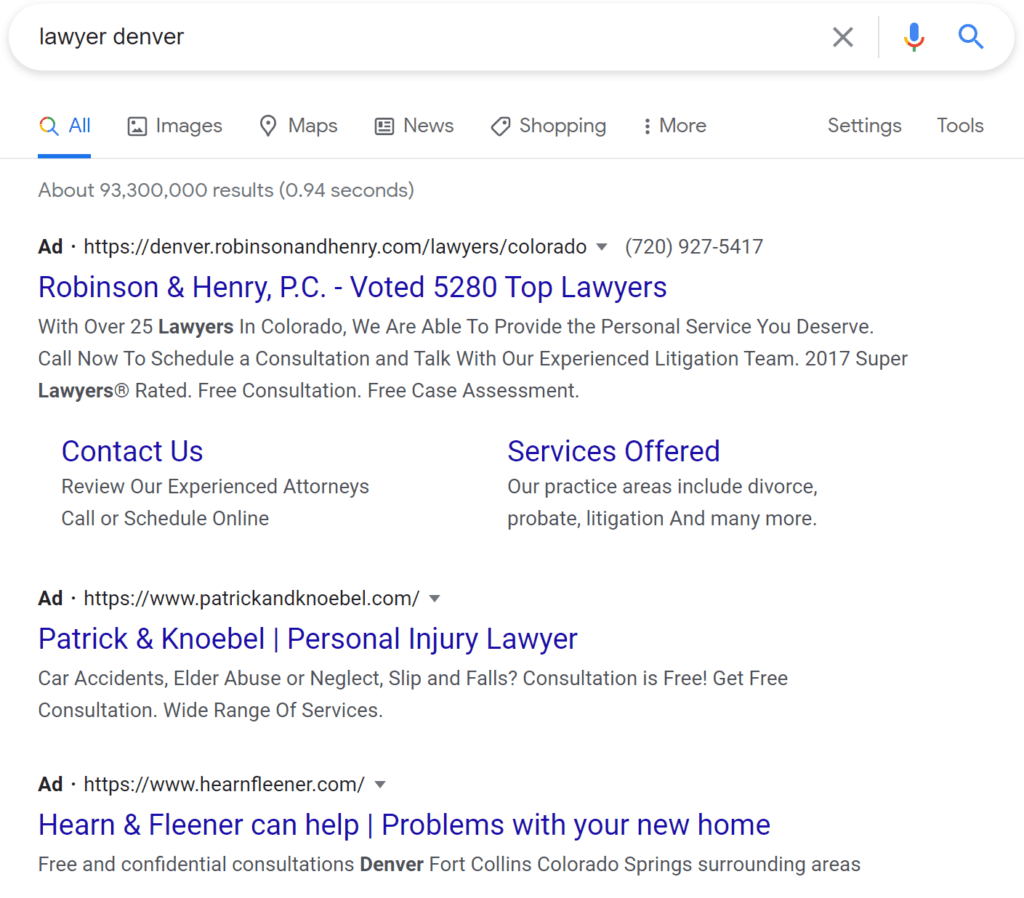
Anyone searching for a lawyer has an immediate need.
PPC ads capture them at this moment, making them a rather effective lead generation strategy for law firms and a favorite among firms of all sizes.
The problem is that, while PPC ads are straightforward to set up, they’re also deceptively easy to mess up.
Failure to set up an ad correctly could lead to thousands of dollars wasted without any results.
The most common mistakes with PPC ads are the simplest ones:
- Your ads aren’t configured for mobile display
- You didn’t set spend limits
- Using the wrong keywords
- The ad links to your homepage rather than a landing page
Most PPC ads networks like Google Ads offer features like demographic targeting, retargeting those that have already visited your website, and phrase match options to dictate how and when your ad appears.
PPC ads may be easy to set up, but you may very well blow your budget with less than desired results if you don’t understand the various features.
Here’s an example, when searching for a marketing guide book, this ad popped up:

I’m not looking for a book marketing expert. I’m looking for a guidebook, but because the advertiser did not set up their ads correctly, the ad appears for my search.
This is most likely due to the words “book” and “marketing”.
By not setting negative keywords or phrase match settings, they’ve wasted money showing up in my search.
Most ads charge per impression, meaning the advertiser pays each time the ad appears in a search rather than how many clicks it gets.
This brings up another point.
Certain ad networks offer more than one payment option.
Cost per click– meaning you pay when someone clicks on your ad.
Cost per impression- you pay each time your ad appears in a search.
Cost per acquisition- you pay for every conversion the ad acquires.
(I also noticed during this search that many law firms miss the opportunity to capitalize on the terms “hire a lawyer near me”. If they’d used exact phrase match settings and targeted my area, they’d show up. Instead, not a single ad popped up.)
PPC ads are one of the best marketing tools for law firms, just be cautious of your budget and leave room for other marketing efforts, like SEO and content.
SEO and Content Marketing
I’ve seen a number of law firms operate without a website, directory profiles, or even a social media presence.
They’ve depended entirely on PPC ads and simple landing pages rather than long-term lead generation strategies like SEO and content.
If you were to operate that way for ten years, you’d bring in approximately the same number of leads at the end of the ten years as you did when you started.
You may even lose leads because most potential clients today expect some level of digital presence.
If you were to spend just 25% of your budget on SEO and content creation, you’d have thousands of pages online.
All of those pages would continue to bring traffic (and potential clients) to your website year after year.
Dolman Law Group is an excellent example of using SEO and blog content to draw traffic and leads.
Their website has almost 50,000 keywords and 165,000 backlinks, giving them a domain rating of 55, which inevitably helps them rake in nearly 75,000 visitors each month.

Right now, their top viewed pages are their blog pages.
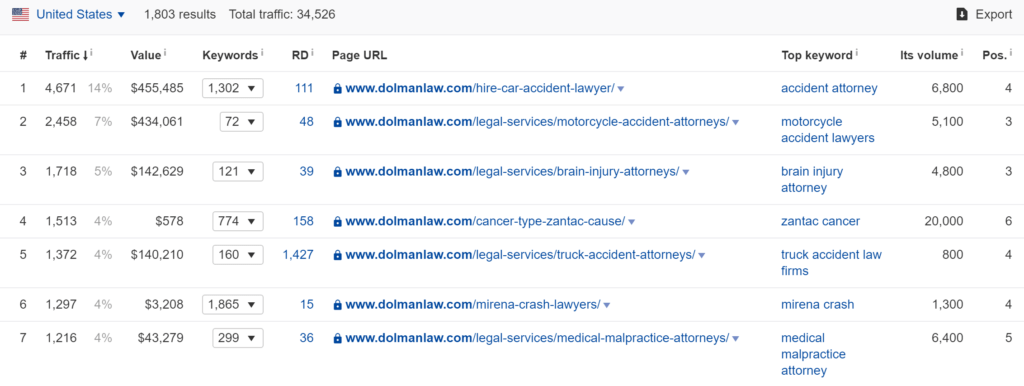
Their best performing page is an article titled, “When Do You Need To Hire A Car Accident Lawyer?” It brings nearly 5,000 people to their website every month.
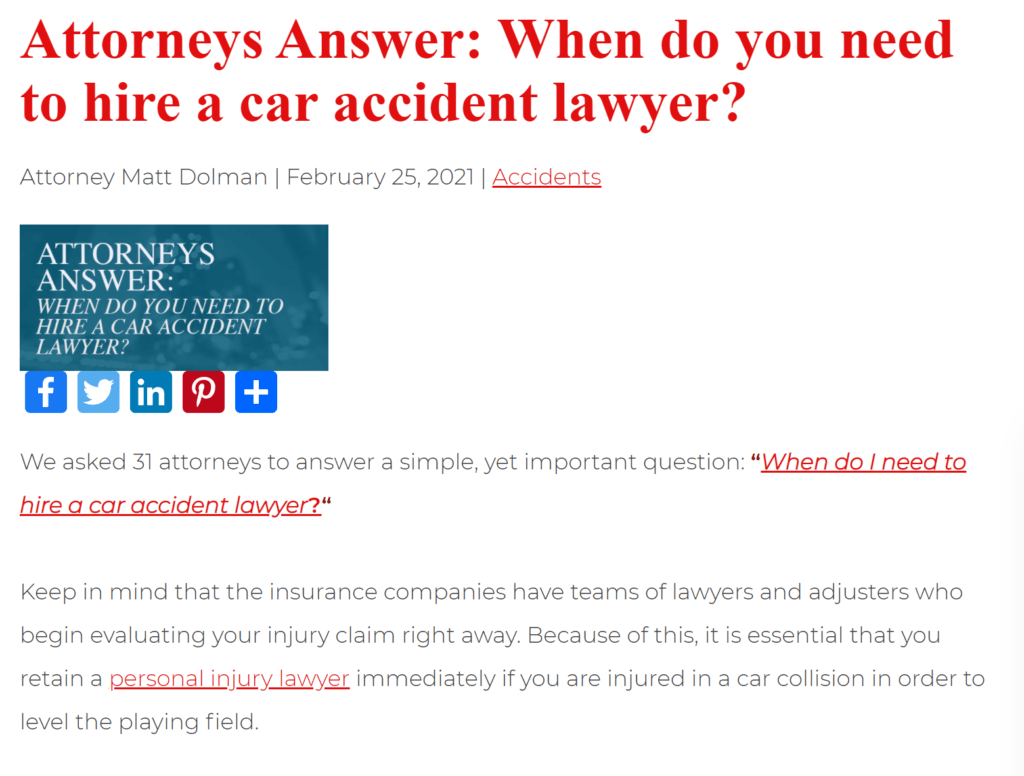
You may spend money to create content once, but the ROI is far greater than the same amount spent on an ad that’ll disappear once the money runs out.
Let’s put this into greater perspective…
Organic traffic on Google hits 81 billion every single month. On average, 85% of website traffic comes from organic search.
By consistently creating content that answers your clients’ questions and concerns, you open up your business to a massive amount of traffic.
That traffic can drive leads to your law firm for years.
Social Media
One of the lawyers I’d interviewed in lieu of this article, Benjamin Rajotte of Rajotte Law Group, mentioned gave me a quick insight into the tactics he employs most often:
“Word of mouth was the earliest form of marketing, and it’s still a vital player today, but it’s moulded into a new shape thanks to the digital age.”
Word of mouth was the earliest form of marketing and it’s still a vital player today, but it’s sort of moulded into a new shape thanks to the digital age.
Social media allows us to talk about a service or company to thousands, or even millions, at once.
Facebook alone sees an average of 2.7 billion users each month.
Now consider that Facebook has groups specifically for different industries and interests.
See the potential?
Platforms like Facebook, Twitter, and LinkedIn make it easy to:
- Draw attention to your law firm
- Establish credibility
- Demonstrate expertise
- Connect you to other experts in your industry
- Create a more tangible persona that people can reach out to and identify with
- Drive more traffic to your website through your bio
The law firm White and Case are a great example of how to use social media.
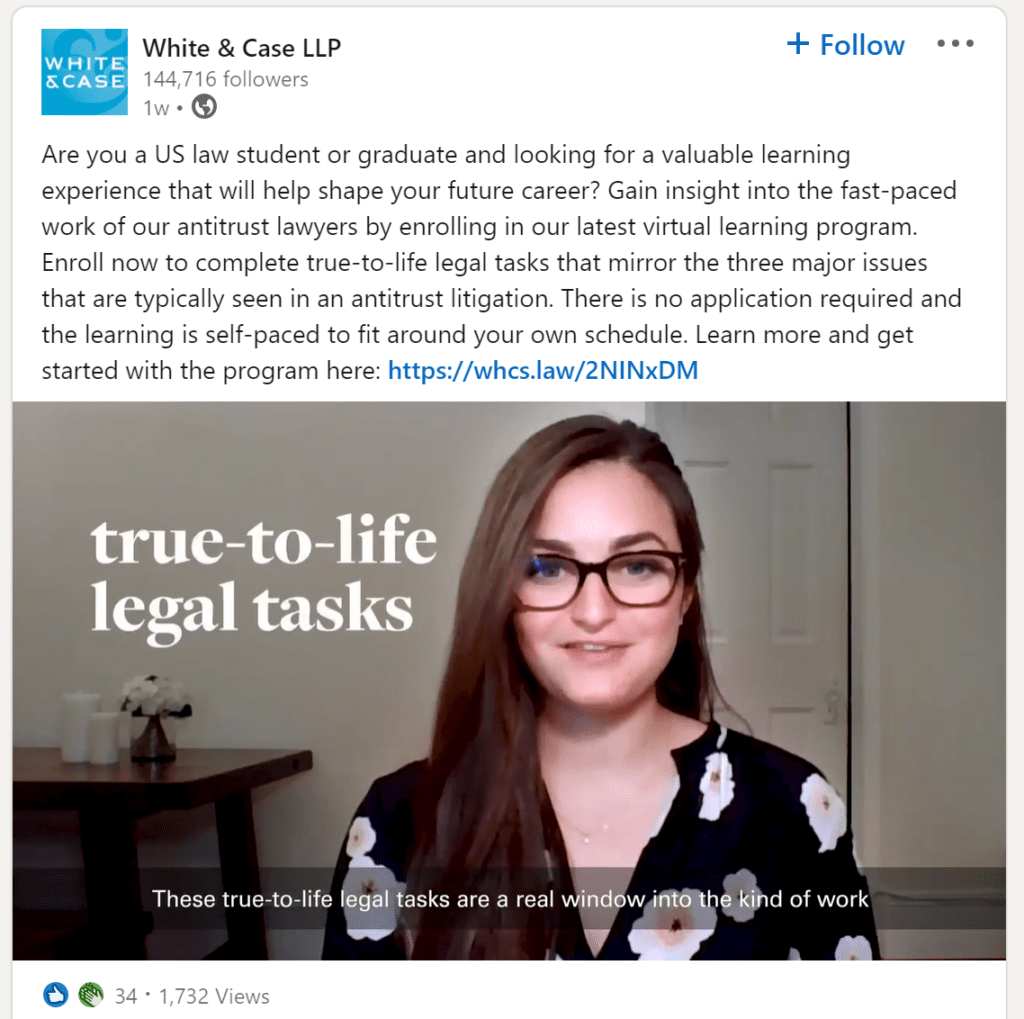
Benjamin Rajotte touched upon the point that human connection is infallible to business. It’s essential to make connections with your community and the people you serve.
To offer value without asking for anything in return.
He may prefer face-to-face encounters, but social media can offer just as many benefits to more people.
You just have to find the proper channels for your audience.
Video Marketing
A single video on your web page makes you 53 times more likely to appear on the first page of a Google search.
On a landing page, a video leads to 80% more conversions than pages without.
Those two factors alone are compelling enough to get anyone to use more video in their marketing.
Now consider the growing demand.
Youtube is the second largest search engine behind Google, with 2 billion users a month and increasing.
Video and live streaming are now features on most social media channels if they are not the medium’s sole composition (Tiktok).
So far, only 24% of lawyers engage in video marketing, and some, like Oremland Law Group, are doing it really well.
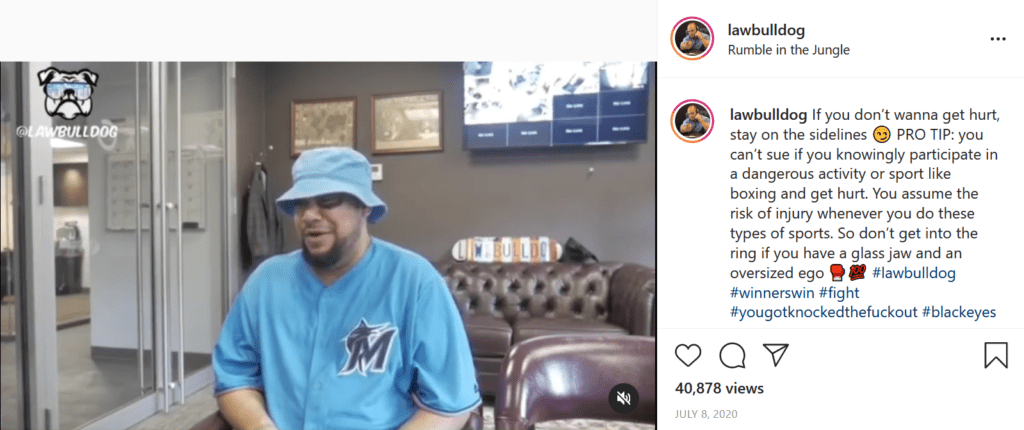
Click here to view the video on their Instagram page
Adam Oremland clearly shows that there’s a creative way for law firms to use video marketing to both inform and attract an audience.
Podcasts
We live in a busy world and in busy times, and most people are trying to find ways to do multiple things at once. Podcasts fit the bill.
They’re entertaining, informing, and best of all, you can listen to them anywhere and at almost any time- driving, working, exercising, cooking…
Podcasts were once solely for news and music, rising with the advent of broadband internet during the 80s, but really only caught on in the early 2000s.
Around 42 million Americans listen to podcasts weekly, and just like video, the demand is only increasing.
Are you seeing a trend?
No matter the industry, people want fast answers and easily consumable information.
Even better if you can make it entertaining.
Besides the demand, podcasts are trending in the marketing world because they’re low cost and time-saving.
You can repurpose a single podcast episode into a blog post, youtube video, social media reel, and several social media posts.
Are you ready to pick up a microphone yet?
Building A Law Firm Marketing Strategy
If you throw a bunch of marketing tactics against the wall to see which sticks, you end up with a lot of blank wall space.
If you want your marketing to work, and work well, plan it out. Develop a strategy that spans at least three months of effort and includes:
- What content you’ll produce
- How much you have to spend on each effort
- Goals for each piece of content
- A distribution plan
When I work with a client on their content strategy, the first things I want to know are the brand and the audience.
That should be your first move too.
For a lot of law firms, seeing your brand as a persona isn’t all that easy. You might think, “we’re just a law firm. There’s no brand.”
That’s incorrect.
You’re a service, and you have a voice. You have a specific way of communicating with clients and a reputation that you uphold. That is your brand.
It’s only after you have a firm grasp of your brand that you can build an effective law firm marketing plan.
Follow along…
Step 1: Getting to know your audience
You may have heard the phrase dozens of times over, but most people still don’t grasp what knowing your audience really means.
In most cases, it’s thought that, “My clients have been in a car accident” or “most of my clients are construction workers who’ve had an accident at work” is enough of an answer.
But you need to get deep to really understand your audience. You need to know:
- Where your audience hangs out online
- What kind of content they consume
- What communities they engage in
- What industries they work in
- How do most people find your business now?
- What concerns and questions do they have about you?
There are quite a few ways of getting to know your clients well:
- Interview past and existing clients
- Ask client-facing employees (the ones answering the phones and fielding questions)
- Check out reviews of your service and get to know the people posting those reviews (social media is a handy tool)
- Create a survey to post on your social media page or to send out to your email list (if you’ve built one)
If you don’t know who you’re speaking to and you don’t know where they engage online, how do you expect to reach them? You need to understand what messages resonate and where to put those messages.
Step 2: Setting goals & choosing marketing strategies
Every strategy AND piece of content should be tied to a goal.
In most cases, the goals are either brand engagement and awareness or conversions.
If you’re aiming for brand awareness (which is usually the case if you’re new to the market and haven’t developed much of a digital presence yet), then your strategy needs to focus on shareable content and social media.
If you’re shooting for conversions, focus on creating case studies, articles that focus on the end of the buyer stage (where people are searching for articles like “how to hire legal services” or “the best legal advice”) and PPC ads.
Your goals and your audience determine your marketing strategies.
Know what your audience needs and how best to reach them and coordinate that with the best marketing tactics that will help you achieve your goals.
**Never solely focus on just conversions or just brand awareness. Those goals can be a focus of your strategy, but mix it up to add variety to your digital presence.**
Step 3: Setting a marketing budget
You can do a lot of marketing with a minimal budget… if you know how to market yourself.
If you can run your social media and write weekly blog content that actually attracts your target audience, then you’re already a step ahead.
The only thing it will cost you is time (and some energy).
If you need a little direction but still wish to handle marketing yourself, there are law firm marketing consultants who can help.
But as we listed above, there are a lot of ways for lawyers to get clients, and whether or not you’re doing them yourself, they’ll cost money (think PPC).
Determine if you need to work with a law firm marketing agency or hire freelancers to handle specific social media management tasks.
Step 4: Continually optimizing and monitoring efforts
Marketing never stops.
Sure, you can set up a PPC ad and continue to pay for that one ad for the life of your business.
You can create a website and never add or change anything.
You can even create a blog post a week and never update them.
But you won’t continue to reap all the benefits of those efforts.
Blog posts can drive traffic and clients to your practice for years, but you’ll get more out of it if you continue to promote the article in forums, with ads, or use it to answer questions on social media.
You’ll get even more organic traffic to the post if you update it every two years with fresh keywords and a bit of new content.
PPC ads can run for ages without being effective, draining your budget without any return. But if you continually optimize them to find which keywords work better or work on your targeting, you’ll yield better results.
Marketing is a constant effort, and without being aware of what’s working and what’s not, you’ll not only miss out on leads, but you’ll waste a ton of money.
Need Help Building Your Marketing Plan?
You know your clients and we know marketing. We can help you build a marketing plan that not only reaches your target audience, but builds lasting relationships that keeps your business growing.


